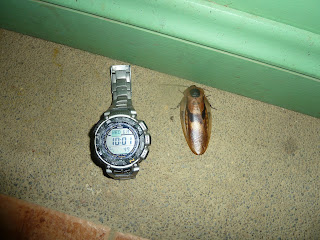Today was a lot of indoor stuff. It's easy to forget that I'm not on vacation and we're here to learn/work.
The effects of last nights storm can be felt all over the station.
The mosquitoes haven't been too tenacious so far, I've probably only gotten 15-20 bites in 2.5 days. We've been informed that it has been lighter than normal in terms of their numbers.
People in the know keep talking about how tomorrow, because of the storm, will be a 'mosquito bloom', and that the next week should be an all out assault from the flying devils.
Did I mention the bugs were huge here?
Archimandrita tessellata (Giant Cockroach).This bad boy was hanging outside our lab. I normally don't get too creeped out by bugs.
I'm willing to make an exception though. Yuck.
Most of the morning and afternoon was spent in workshops. We had one on 'what not to do when giving a presentation', conversational Spanish, scientific writing, and how try and not get lost at La Selva.
At one point they had us walk out into the middle of the jungle, spin around, and try to find our way back using a compass.
We all did a pretty good job finding our way home.
And to top it off we found something awesome that I've only ever heard of in Planet Earth.
It's called a cordyceps fungus. it infects invertebrates and feeds off of non-vital organs while changing the hosts behavior. It grows into the brain and releases chemicals to force the host to move to higher spots in the forest. There it devours the brain, killing the host, and proceeds to grow mushrooms out of the body to release spores....AWESOME!
Basiliscus vittatus (Striped Basilisk) These are apparently super-common around La Selva, it just took me a few days to finally see one. Kelly and I saw juvenile basilisk lizards in the mangrove swamps of Manual Antonio at a kayak tour during our honey-moon. The juveniles are able to run across the top of water to escape predators, hence their other common name- 'Jesus-Christ Lizard'.
After dinner we got a real treat.
The herp walk.
Finally.
Ctenus sp. (Wandering Spider) This spider is in the family Ctenidae, its cousin, the Brazilian Wandering Spider, is the most venomous spider on the planet. A component of the venom causes priapism in humans. Erections are painful, last for hours, and lead to impotence. This on couldn't be identified, but Steven called it the "stay-the-f*ck-away-spider".
I walked under a tree in the swamp and felt what I thought was some bugs in my hair. When I brushed my hands through, I felt something small, squishy, and wet.
These are the eggs of one of my study species. They lay GIANT egg masses in the trees to protect them from aquatic predators like fish. There had to be >10,000 eggs in a single giant mass!
When they're ready to hatch as tadpoles they wiggle out of their eggs and splash into the water, where they immediately swim for cover and hopefully metamorphose into...
Agalychnis callidryas (Red-eyed Tree Frog) This is one of my study species and easily my favorite frog of all time. Every time we saw this species there was a male (smaller) clamped onto the female in a behavior called amplexus. They weren't necessarily mating, but the males latch on in hopes the females will start releasing eggs for them to fertilize.
Come on guys, lock it up and show some composure
Apparently this species is composed of entirely high-school aged males.
Steven says he has come across females being eaten by snakes with a male still partially clinging on in hopes of one last quickie...
Tenacity.
I like that.
Norops capito (Pug-nosed Anole) I'll be working with two other species of Norops sp. This little lady was not very happy with our intrusive photos. She scared the living out of all of us by exploding off the leaf and squawking after a flash went off.
Corytophanes cristatus (Helmeted lizard) I really liked this guy. He didn't care one bit with us "ohh"-ing and "ahh"-ing all over his hang-out spot.
Trogon violaceus (Violaceous Trogon) Apart from having an epic name, this bird has a great nesting behavior. It hollows out active wasp nests half-way and lays its eggs.Their chicks feed off the remaining wasps, being careful never to eat them all. This deters predators from messing with the nest. Awesome.
Craugastor megacephalus These little critters are too cute and one of the species in decline at La Selva... hopefully I'm down here to figure out why!
(Big-ass Spider) I have no idea what this thing is and this is about as close as I ever want to get. I should have put something up for you to see the scale. 1 in.=HUGE!
Eleutherodactylus diastema (Tink frog) I'm not sure if I identified these right. Another great example of desperation at its best though.
Urotheca euryzone (Halloween Snake) I just about lost my marbles when I first saw this bad-boy. I mistakenly assumed it was a coral snake. This snake uses mimicry to deter potential predators.
It also uses mimicry to fool young, aspiring herpetologists into thinking they've seen a once-in-a-lifetime-awesome-deadly-venomous snake... only to let them down when they realize they're looking at a glorified gopher snake.
Que the sad horns and Charlie Brown music.
Woh-woh.
I know what you're thinking. I thought the same thing too. The Donald Trump Caterpillar. Unfortunately I have no idea what these things are. Any hairy caterpillar you come across in the jungle is a big no-no to touch though. Their hairs can cause intense burning and pain that lasts for hours.
Gastrophryne pictiventris (Reticulated Sheep Frog) Pretty darn cute.















No comments:
Post a Comment